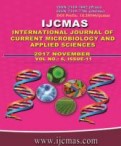


 National Academy of Agricultural Sciences (NAAS)
National Academy of Agricultural Sciences (NAAS)

|
PRINT ISSN : 2319-7692
Online ISSN : 2319-7706 Issues : 12 per year Publisher : Excellent Publishers Email : editorijcmas@gmail.com / submit@ijcmas.com Editor-in-chief: Dr.M.Prakash Index Copernicus ICV 2018: 95.39 NAAS RATING 2020: 5.38 |
P is a key factor responsible of continental water eutrophication. In lagoon Porto-Novo sediments, it arises from slope basin supplies and biological activity. The present study has the main objective to evaluate phosphorus release rate coming from lagoon sediment, and to analyse the availability of these nutrient fractions. Four sampling point served to take up waters and sediments destined to analyses. The first five centimetres of sediments and waters were used and analyses (sequential extraction method) carried out on fraction 250 µm, lyophilized for phosphorus fractionation. Phosphorus release rate was calculated applying Nürnberg regression equations which have been built from PT concentrations measured in seven Ontario and Connecticut Lake sediments. One-way variance analysis (ANOVA 1) using Dunnett method and Pearson (r) correlation implemented in MINITAB and JMP were applied. Results showed different phosphorus forms inside sediment. These forms were: P-labile, P-Fe, P-Ca, P-Al and P-Org accompanied by P-reside with a rate in mobilizable phosphorus reaching 66.39% PT. P-Org was the most abundant, attaining proportion between 452.6±53.50 µgP/g -2035.4±311.2 µgP/g of dry sediment, consequence of organic matter accumulation from slope basin due to diverse human activities, and animal and plant organic matters present on the watershed. P-Ca is relatively more found in station S1 and S4 in contrast to S2 and S3. Release rate (TL) registered (11,05 mg*m-2*j-1) indicates then that lagoon Porto-Novo is in a more or less advanced degradation state with an internal load estimated by156,03 mg*m-2*saison-1. These results should be helpful for local and national authorities and stakeholders in setting environmental policies regarding phosphorus reduction, particularly that flowing from slope basin.
 |
 |
 |
 |
 |